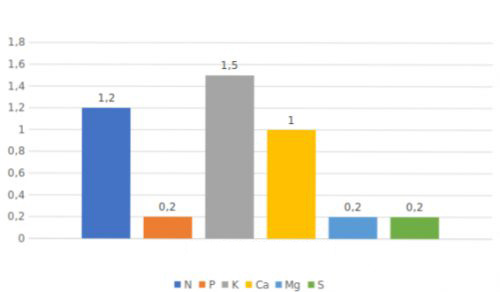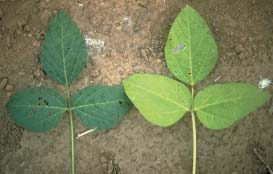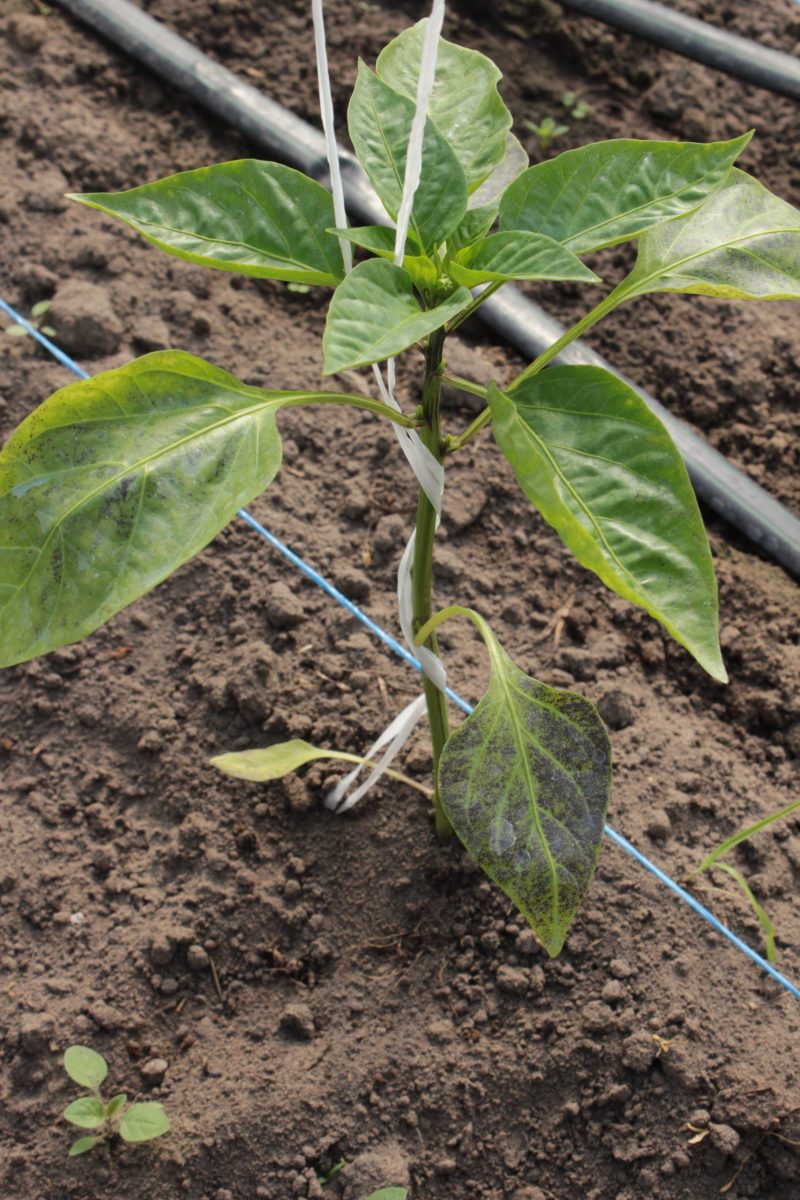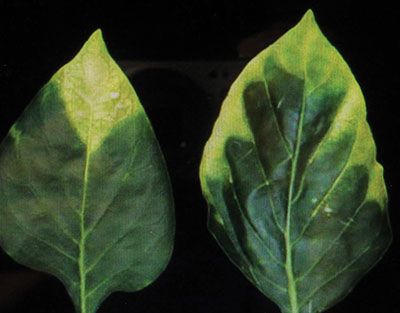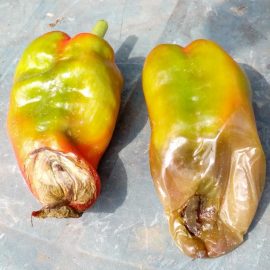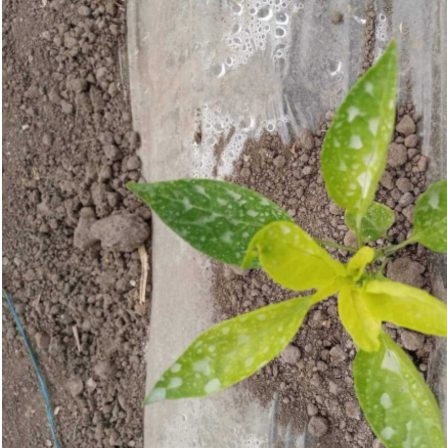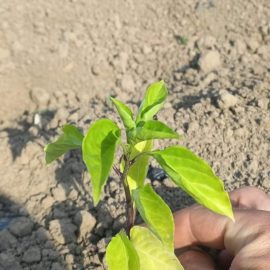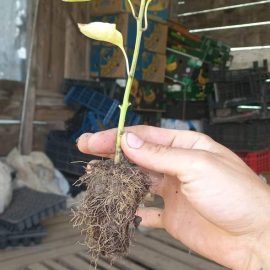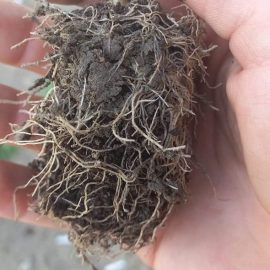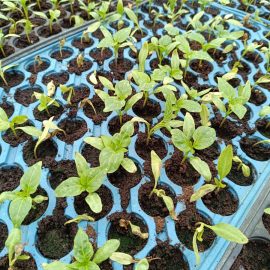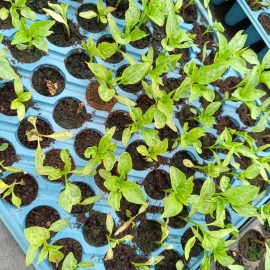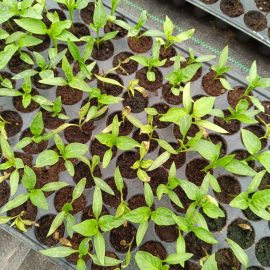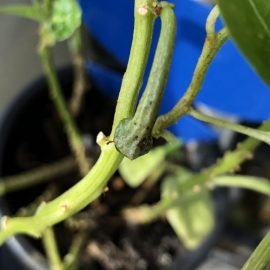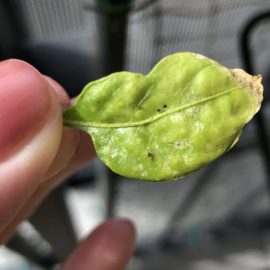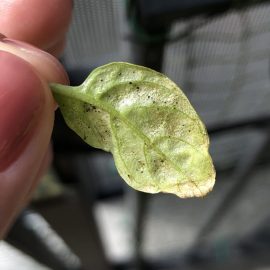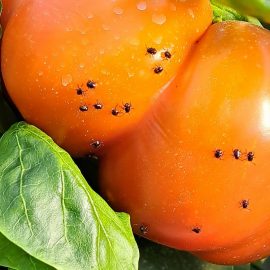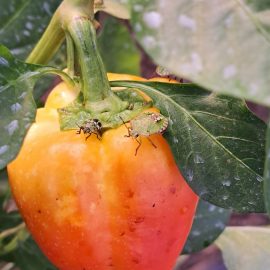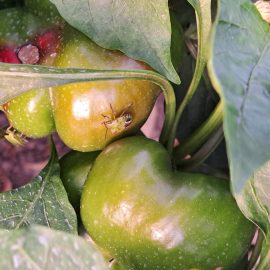Pepper – Fertilization during various stages of crop growth
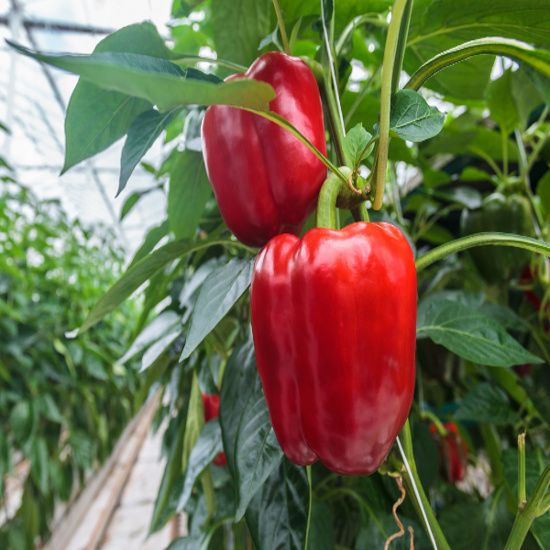
The pepper belongs to the Solanaceae family. The vegetative development phase is relatively long. They require a lot in terms of environmental factors such as exposure to sunlight, temperature, and humidity.
Because of their production capacity, the crops cultivated in the fields or protected spaces need a lot of nutrients.
Peppers, like all plant species, experience critical growth periods during the growing season. The first critical period occurs in the early stages of vegetative growth (about 14 days after planting), and then at the beginning of flowering, when the first fruits appear, and when the fruits reach 50% of their normal size. This species shows a high uptake during the first part of the growing season and then decreases after the first harvest.

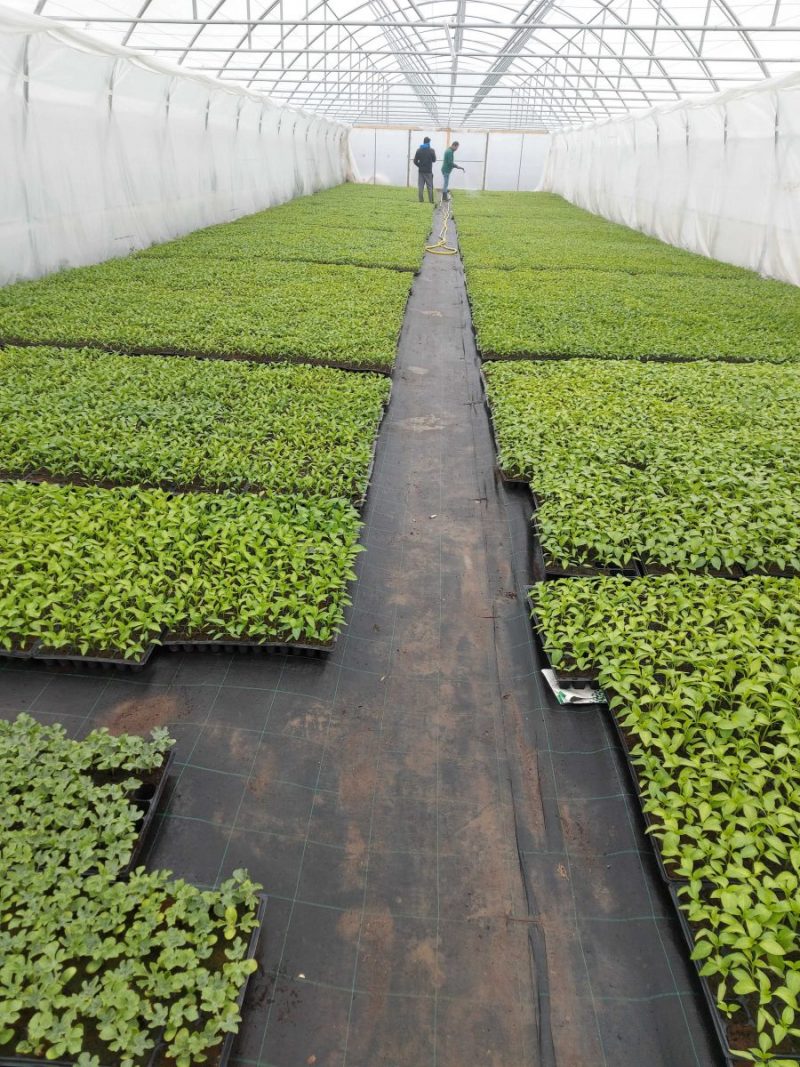
Essential nutrients
Nitrogen (N) that is provided to plants affects their development and production.
Nitrogen is absorbed from the soil as NH4+ or NO3- ions. The use of nitrogen forms is conditioned during the growing season by several factors, such as soil pH, species, and plant age.
Phosphorus (P) is an essential nutrient for growth, development of root system, blossoming, and early fruit maturation. It is responsible for storing energy and transporting it into the cell.
Potassium (K) is one of the essential plant macronutrients and is taken up by crops in large quantities. The ability of plants to protect themselves against diseases, pests, and climatic conditions is due to the action of potassium in the plant. Potassium not only impacts plant resistance but also crop quality.
Calcium (Ca), which is present in cell walls and membranes, is another necessary nutrient. A deficient supply of this element can lead to the effect of small, cup-like leaves, flowers may be aborted, but there is also a risk of apical tip rot.
Magnesium is a critical nutrient that acts throughout the vegetative growth cycle, performing a variety of roles including:
- is the central component of chlorophyll, involved in photosynthesis;
- is the carrier of phosphorus in plants;
- it’s involved in the cell division process.
Sulfur is considered to be a vital nutrient in plant growth because it performs a variety of roles, including:
- it helps in the process of chlorophyll synthesis;
- it is essential in the production of proteins, vitamins, and enzymes and it helps plants during their dormant stage.
The consumption of pepper crop macronutrients
Nitrogen deficiency
It has been described as follows:
- slower development rate;
- the ramifications are low;
- the leaves have a small surface size;
- lower harvest and lower protein content;
- leaves turning yellow or chlorotic.
Measures to deal with the deficiency
- using a fertilizer that has a higher amount of nitrogen during the soil preparation and growth cycle.
Recommended products
-
You can find products on a different store
Change Store -
You can find products on a different store
Change Store -
You can find products on a different store
Change Store -
You can find products on a different store
Change Store -
You can find products on a different store
Change Store -
You can find products on a different store
Change Store -
You can find products on a different store
Change Store -
You can find products on a different store
Change Store -
You can find products on a different store
Change Store -
You can find products on a different store
Change Store -
You can find products on a different store
Change Store -
You can find products on a different store
Change Store -
You can find products on a different store
Change Store -
You can find products on a different store
Change Store -
You can find products on a different store
Change Store -
You can find products on a different store
Change Store -
You can find products on a different store
Change Store -
You can find products on a different store
Change Store -
You can find products on a different store
Change Store -
You can find products on a different store
Change Store -
You can find products on a different store
Change Store -
You can find products on a different store
Change Store -
You can find products on a different store
Change Store -
You can find products on a different store
Change Store
Phosphorus deficiency
The first symptoms appear as follows:
- delayed growth, and poor ramification;
- plants affected by this deficiency show pale red, purple red to dark burgundy coloring on mature leaves.
Measures to correct the deficiency
- fertilizing with products containing high concentrations of P.
Recommended products
-
You can find products on a different store
Change Store -
You can find products on a different store
Change Store -
You can find products on a different store
Change Store -
You can find products on a different store
Change Store -
You can find products on a different store
Change Store -
You can find products on a different store
Change Store -
You can find products on a different store
Change Store -
You can find products on a different store
Change Store -
You can find products on a different store
Change Store -
You can find products on a different store
Change Store -
You can find products on a different store
Change Store -
You can find products on a different store
Change Store -
You can find products on a different store
Change Store -
You can find products on a different store
Change Store -
You can find products on a different store
Change Store -
You can find products on a different store
Change Store -
You can find products on a different store
Change Store -
You can find products on a different store
Change Store -
You can find products on a different store
Change Store -
You can find products on a different store
Change Store -
You can find products on a different store
Change Store -
You can find products on a different store
Change Store -
You can find products on a different store
Change Store -
You can find products on a different store
Change Store
Potassium deficiency
Deficiencies generated by the lack of potassium are visible by:
- chlorosis on the edge of the leaves;
- the tips of leaves are curling and browning, and the stem is stiff and prone to falling;
- pepper plants are no longer able to grow.
Measures to correct the deficiency
- fertilizing with products containing K2O.
Recommended products
-
You can find products on a different store
Change Store -
You can find products on a different store
Change Store -
You can find products on a different store
Change Store -
You can find products on a different store
Change Store -
You can find products on a different store
Change Store -
You can find products on a different store
Change Store -
You can find products on a different store
Change Store -
You can find products on a different store
Change Store -
You can find products on a different store
Change Store -
You can find products on a different store
Change Store -
You can find products on a different store
Change Store -
You can find products on a different store
Change Store -
You can find products on a different store
Change Store -
You can find products on a different store
Change Store -
You can find products on a different store
Change Store -
You can find products on a different store
Change Store -
You can find products on a different store
Change Store -
You can find products on a different store
Change Store -
You can find products on a different store
Change Store -
You can find products on a different store
Change Store -
You can find products on a different store
Change Store -
You can find products on a different store
Change Store -
You can find products on a different store
Change Store -
You can find products on a different store
Change Store
Calcium deficiency
Calcium deficiency generally manifests very differently, the main symptoms could be:
- browning of the plant’s young tissues near the top;
- development of a blackish-brown rot and blossom;
- dark green, curly leaves;
- flower abortion.
Measures to correct the deficiency
- reducing acidity levels by amending the soil with specific products;
- fertilization with Ca-based products.
Recommended products
-
You can find products on a different store
Change Store -
You can find products on a different store
Change Store -
You can find products on a different store
Change Store -
You can find products on a different store
Change Store -
You can find products on a different store
Change Store -
You can find products on a different store
Change Store -
You can find products on a different store
Change Store -
You can find products on a different store
Change Store -
You can find products on a different store
Change Store -
You can find products on a different store
Change Store -
You can find products on a different store
Change Store -
You can find products on a different store
Change Store -
You can find products on a different store
Change Store -
You can find products on a different store
Change Store -
You can find products on a different store
Change Store -
You can find products on a different store
Change Store -
You can find products on a different store
Change Store -
You can find products on a different store
Change Store -
You can find products on a different store
Change Store -
You can find products on a different store
Change Store -
You can find products on a different store
Change Store -
You can find products on a different store
Change Store -
You can find products on a different store
Change Store -
You can find products on a different store
Change Store
Magnesium deficiency
Magnesium deficiency is observed through:
- chlorosis between veins;
- in case of a high-intensity deficiency, the tissues turn yellow, brown, and necrotic;
- the leaves are small and tear easily.
Measures to correct the deficiency
- applying fertilizers containing Mg.
Recommended products
-
You can find products on a different store
Change Store -
You can find products on a different store
Change Store -
You can find products on a different store
Change Store -
You can find products on a different store
Change Store -
You can find products on a different store
Change Store -
You can find products on a different store
Change Store -
You can find products on a different store
Change Store -
You can find products on a different store
Change Store -
You can find products on a different store
Change Store -
You can find products on a different store
Change Store -
You can find products on a different store
Change Store -
You can find products on a different store
Change Store -
You can find products on a different store
Change Store -
You can find products on a different store
Change Store -
You can find products on a different store
Change Store -
You can find products on a different store
Change Store -
You can find products on a different store
Change Store -
You can find products on a different store
Change Store -
You can find products on a different store
Change Store -
You can find products on a different store
Change Store -
You can find products on a different store
Change Store -
You can find products on a different store
Change Store -
You can find products on a different store
Change Store -
You can find products on a different store
Change Store
Sulfur deficiency
In many cases, when sulfur deficiency occurs, it is similar to N (nitrogen) deficiency.
- unlike the N deficiency, the S deficiency occurs on young leaves in the upper part of the plant;
- foliage and tissues turn yellowish green;
- growth is slowed;
- sulfur deficiency also reduces the accessibility of molybdenum (which is involved in the nitrogen fixation process).
Measures to correct the deficiency
- repeated fertilization with products containing S.
Recommended products
-
You can find products on a different store
Change Store -
You can find products on a different store
Change Store -
You can find products on a different store
Change Store -
You can find products on a different store
Change Store -
You can find products on a different store
Change Store -
You can find products on a different store
Change Store -
You can find products on a different store
Change Store -
You can find products on a different store
Change Store -
You can find products on a different store
Change Store -
You can find products on a different store
Change Store -
You can find products on a different store
Change Store -
You can find products on a different store
Change Store -
You can find products on a different store
Change Store -
You can find products on a different store
Change Store -
You can find products on a different store
Change Store -
You can find products on a different store
Change Store -
You can find products on a different store
Change Store -
You can find products on a different store
Change Store -
You can find products on a different store
Change Store -
You can find products on a different store
Change Store -
You can find products on a different store
Change Store -
You can find products on a different store
Change Store -
You can find products on a different store
Change Store -
You can find products on a different store
Change Store














































































































































































































































































































































































































































